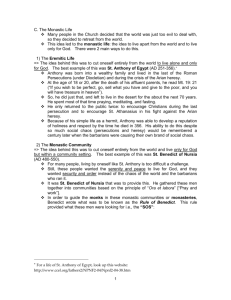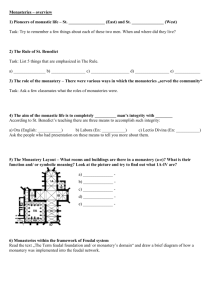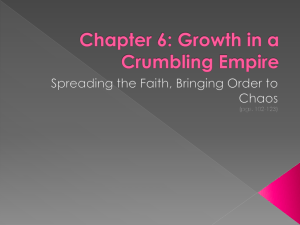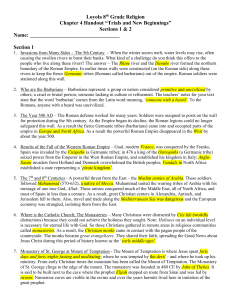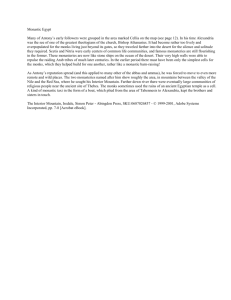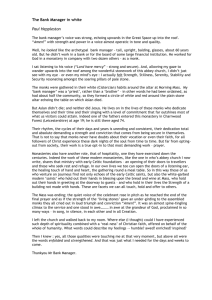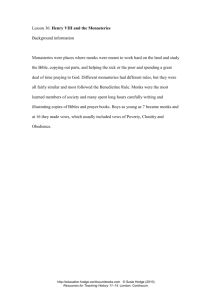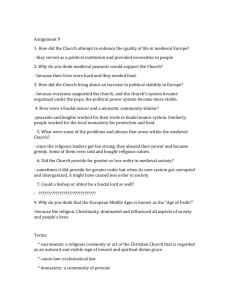MS Word format, with footnotes - Christianity For Thinkers Home Page
advertisement
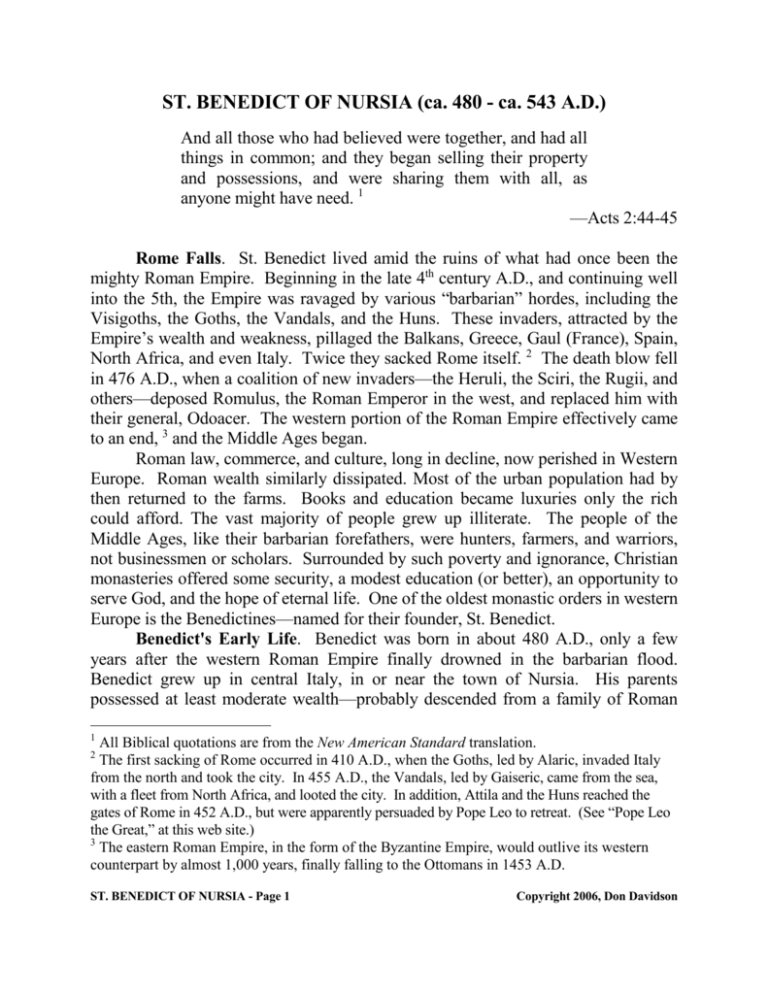
ST. BENEDICT OF NURSIA (ca. 480 - ca. 543 A.D.) And all those who had believed were together, and had all things in common; and they began selling their property and possessions, and were sharing them with all, as anyone might have need. 1 —Acts 2:44-45 Rome Falls. St. Benedict lived amid the ruins of what had once been the mighty Roman Empire. Beginning in the late 4th century A.D., and continuing well into the 5th, the Empire was ravaged by various “barbarian” hordes, including the Visigoths, the Goths, the Vandals, and the Huns. These invaders, attracted by the Empire’s wealth and weakness, pillaged the Balkans, Greece, Gaul (France), Spain, North Africa, and even Italy. Twice they sacked Rome itself. 2 The death blow fell in 476 A.D., when a coalition of new invaders—the Heruli, the Sciri, the Rugii, and others—deposed Romulus, the Roman Emperor in the west, and replaced him with their general, Odoacer. The western portion of the Roman Empire effectively came to an end, 3 and the Middle Ages began. Roman law, commerce, and culture, long in decline, now perished in Western Europe. Roman wealth similarly dissipated. Most of the urban population had by then returned to the farms. Books and education became luxuries only the rich could afford. The vast majority of people grew up illiterate. The people of the Middle Ages, like their barbarian forefathers, were hunters, farmers, and warriors, not businessmen or scholars. Surrounded by such poverty and ignorance, Christian monasteries offered some security, a modest education (or better), an opportunity to serve God, and the hope of eternal life. One of the oldest monastic orders in western Europe is the Benedictines—named for their founder, St. Benedict. Benedict's Early Life. Benedict was born in about 480 A.D., only a few years after the western Roman Empire finally drowned in the barbarian flood. Benedict grew up in central Italy, in or near the town of Nursia. His parents possessed at least moderate wealth—probably descended from a family of Roman 1 All Biblical quotations are from the New American Standard translation. The first sacking of Rome occurred in 410 A.D., when the Goths, led by Alaric, invaded Italy from the north and took the city. In 455 A.D., the Vandals, led by Gaiseric, came from the sea, with a fleet from North Africa, and looted the city. In addition, Attila and the Huns reached the gates of Rome in 452 A.D., but were apparently persuaded by Pope Leo to retreat. (See “Pope Leo the Great,” at this web site.) 3 The eastern Roman Empire, in the form of the Byzantine Empire, would outlive its western counterpart by almost 1,000 years, finally falling to the Ottomans in 1453 A.D. 2 ST. BENEDICT OF NURSIA - Page 1 Copyright 2006, Don Davidson patricians—for they could afford to send their son to Rome to obtain his education. There, at about the age of 15, he became a hermit. This sudden piety resulted in part from his disgust at the immorality in Rome, but it may have also been an effort to escape the pain of rejection by a girl he loved. (Benedict is said to have overcome this emotional hurt by jumping unclothed into a patch of thorn bushes.) Benedict's precise motivation remains unclear. But regardless of his reasons, Benedict left Rome and went to live in a cave by himself. He gradually became well-known for the austerity of his lifestyle and the sincerity of his devotion to God. After some years, the monks of a nearby monastery asked him to be their abbot, but could withstand the severity of his rule for only a few months. When some of the monks tried to poison Benedict, he left and resumed his solitary life. He soon attracted other monks of similar passion— almost 150 of them by 520 A.D.—and in about 529 A.D., he took the most zealous of these followers and built a monastery at Monte Cassino, 4 45-50 miles north of Naples and 1,715 feet above sea level. This marked the beginning of the Benedictines. The Benedictine Order of Monks. The rules Benedict adopted for Monte Cassino became the foundation upon which most monastic orders in Western Europe would be built. Benedict originated the monastic vows, 5 which entailed a solemn, lifelong commitment to God, the monastery, and the monastic way of life. Benedict also instituted the novitiate—a one-year probationary period during which a prospective monk could learn the rigors he would have to endure. If he completed his novitiate and took the vows of a monk, he could quit the monastery only with the abbot's permission (but his own misbehavior could still result in his expulsion). Benedictine monks owned nothing, except in common with the other monks. Benedict required that they give all of their property to the poor or to the monastery when they entered. In this respect, Benedict patterned his monasteries after the 1st century Christian church described in Acts. 6 The monks spoke only when 4 Monte Cassino, built on the ruins of a pagan temple, is now the oldest monastic community in Western Europe. The monastery building was ravaged by the Lombards in 589; demolished by the Saracens in 884; wrecked by earthquake in 1349; despoiled by the French in 1799; and razed to the ground in 1944 by Allied bombs during World War II. Each time the monks came back and repaired or rebuilt the monastery. Monte Cassino was also the site of a Benedictine convent for nuns, established by Benedict's twin sister, Scholastica, in about 530 A.D., with Benedict's help and guidance. Benedictine convents, like Benedictine monasteries, spread throughout Western Europe. 5 The Benedictine vows were to: "the perpetuity of his stay, the reformation of his manners, and obedience." See Durant's The Story of Civilization, Volume 4 (The Age of Faith), at page 518. 6 See Acts 2:44-45: ST. BENEDICT OF NURSIA - Page 2 Copyright 2006, Don Davidson necessary, were forbidden to laugh out loud, and were to walk humbly—looking down at all times. During the fall and winter the monks ate only once a day; in the longer days of spring and summer they were allowed two daily meals. One of the monks would read a religious book out loud as they dined. Fasting was permitted, but not to the point of affecting health. Clothing was simple. Prayer was frequent: eight times a day, at roughly three-hour intervals. 7 Every day included time for prayer, worship, reading, and private meditation, but each of the monks also worked at some job, such as tilling the soil, tending the monastery's various shops, doing household chores, or copying manuscripts. Many of the advances in agriculture during the Middle Ages were discovered on monastic farms. Benedict insisted that each monastery should be self-supporting and selfsufficient, and that every monastery should have a library. The other monks chose the abbot, who was in charge of the monastery. His role was like that of a father— his authority was absolute, but he was to care for the monks placed in his charge, and Benedict's rules reminded him that he was ultimately answerable to God for his administration. The monks lost all privileges and disadvantages upon entry into the monastery. They were considered equal, and were treated according to their character and behavior within the monastic community, regardless of their previous lives. Benedict stressed that his monks should strive for Christian perfection, beginning with Jesus' two greatest commandments: love the Lord God with their whole heart, and love their neighbor as themselves. 8 Benedict urged his followers to obey the Ten Commandments; to be kind to the poor and the sick; to love their enemies and endure injuries without complaint; and to always remember the mercy of God. He decreed that hospitality was to be shown to all: "All guests who come shall be received as though they were Christ." 9 Benedictine monastic life was simple and strict, but not unusually harsh by the standards of the time. Indeed, the life of a Benedictine monk was relatively secure and comfortable when compared to the poverty-stricken majority of the And all those who had believed were together, and had all things in common; and they began selling their property and possessions, and were sharing them with all, as anyone might have need. 7 The Benedictine monks prayed at 2:00 a.m.; 6:00 a.m.; dawn; 9:00 a.m.; noon; 3:00 p.m.; sunset; and bedtime, which came at nightfall. 8 See Matthew 22:35-40; Mark 12:28-31; Luke 10:25-27. 9 Durant's The Story of Civilization, Volume 4 (The Age of Faith), at page 518, citing the Rule of St. Benedict, Chapter 53, as quoted in F. Ogg’s Source Book of Medieval History (New York, 1907), p. 87. ST. BENEDICT OF NURSIA - Page 3 Copyright 2006, Don Davidson people during the Middle Ages. And while many monasteries tried to minimize contact with the outside world, most of the Christian missionaries during the Middle Ages were monks. In short, in a time aptly nicknamed the "Dark Ages" because of its violence, ignorance, and selfishness, monasteries still shone God's light in the world. That was Benedict's legacy. He died in about 543 A.D. Sources: (1) (2) (3) The Story of Civilization, Volume 4 (The Age of Faith), by Will Durant (1950). A History of Christianity, Volume 1 (Beginnings to 1500), by Kenneth Scott Latourette (1953, 1975). Microsoft Encarta 98 Encyclopedia (1998 Edition). ST. BENEDICT OF NURSIA - Page 4 Copyright 2006, Don Davidson
